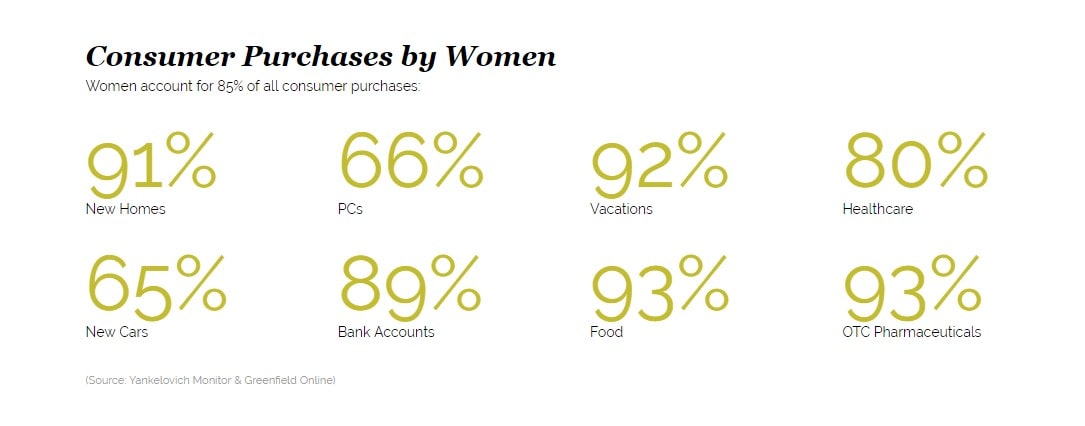How To Market To Women Customers – 4 Recommendations
As a marketer, your job is to find the best way to connect with your customers. Are you marketing to women customers? Then this article is for you.
Bridget Brennan is the CEO of Female Factor, a firm helping businesses develop marketing and sales strategies for women consumers. In her books, Why She Buys and Winning Her Business, she provides valuable insights into marketing and selling to women.
Before I go into Bridget’s insights and recommendations, I invite you to direct your attention to the following statistics on the purchasing power of women via girlpowermarketing.com:
- Women control over $20 trillion in worldwide spending;
- 74.9% of women identified themselves as the primary shoppers for their households;
- In 61% of all consumer electronics purchases, a woman either initiated the purchase or was involved in the purchase process.

girlpowermarketing.com
Here are two insights that every marketer should take into account when building marketing campaigns focused on women:
1. Women are “multiple markets in one”
What does that mean? To understand this, let’s think about Christmas time. Who buys the presents for everyone in the house and for the members of the extended family? The lady of the house. She buys presents for her children, her husband, his colleagues at the office, her elderly parents and in-laws, cousins and friends.
Of course, this situation is not limited to celebrations spending. Women buy on behalf of the people who live in their households on a regular basis.
Women influence various industries and marketers should take that into account.
2. Don’t rely on the name that’s on the credit card
Just because the name on the credit card which pays for purchases is a man’s name, refrain from jumping to the conclusion that he is making the buying decisions.
It’s still the woman who makes the buying decision.
Here are Bridget’s recommendations on how to market to women:
1. Study women as you would a foreign market
Women think differently and they experience life in a different way than men.
Discover their desires and goals, their fears and behaviours.
What are they fighting for and what are they fighting with. Put yourself in their shoes.
Learn more: 3 Brands In Crisis in 2018: KFC, Nike, Victoria’s Secret
Victoria’s Secret is a brand which hasn’t put itself in women’s shoes (or lingerie) in a very long time. It might never have done that this in the first place.
The glamorous women’s lingerie brand was founded in 1977 and it is still marketing like it’s 1977. Retail analyst Paul Lejuez says women don’t want to be viewed as stereotypical sexy supermodels buying lingerie just to impress men.
That’s why Victoria’s Secret has seen fierce competition in recent years from brands such as ThirdLove, Aerie and Savage x Feinty by Rihanna which design their products to meet women’s needs of comfort, beauty and sexiness.
2. Track demographics changes across generations
Life has changed a lot for women. There are many differences between Baby Boomers women, Gen Z women and Millennial women. They have different aspirations for their personal and professional lives. They have different outlooks on motherhood, beauty, marriage and relationships.
There is a female culture and it should be studied by marketers with the same focus that studying a foreign market requires. Cultural differences dictate language, behaviours and perceptions.
Bridget Brennan
Here are 4 interesting insights focused on women according to reports conducted by PwC:
- Women have fewer children;
- Women have children later in life;
- Women are the main caretakers and breadwinners in many households;
- Women are a growing purchasing power: 70% of household budgets in the G7 are controlled by women, globally 85% of consumer purchases are made by women which is equivalent to a worldwide spend of $20 trillion.
Read more about the latest demographic and social changes: PwC: 5 MegaTrends Affecting Your Business in 2019
3. Stay clear of pink unless you are raising money for the breast cancer cause
The colour pink has been synonymous with female nature for a very long time because manufacturers and designers didn’t know any better.
To illustrate an entire gender with just one colour is simply not good enough and frankly offensive. Women struggle with life’s hardships just like men. Unlike men, women juggle with many roles on a daily basis and manage to come out on top.
Women are not delicate princesses dressed in pink gowns and they certainly don’t see themselves as that. They are not powerless and don’t wait for men to come and rescue them.
4. Hire women
Research reports show organisations with women in management are more innovative as the share of female managers increases above 20%.
Reports conducted by The Anita Borg Institute for Women and Technology show that teams which included at least one woman had a collectively higher IQ than teams that had just men.
If your company is looking to market to women, hire women in your product design and development team to represent your customers.
Learn how to attract and retain female talent in the workplace: LinkedIn Report: 4 Trends Transforming The Workplace in 2019
Join the Conversation
We’d love to hear what you have to say.
Get in touch with us on Facebook Group and Twitter.